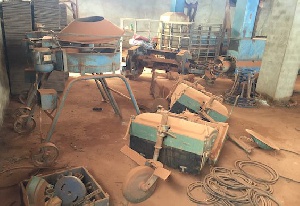Ginger producers at Gyankobaa in the Ashanti Region have appealed to the government to revive a defunct ginger factory in the area to boost production in order to improve the livelihoods of the locals.
The factory, set up in 1975 to dry and mill ginger in produced by the farmers at Gyankobaa is in the Atwima Nwabiagya District, has been shut for over two decades. It is not clear what caused the collapse of the factory, as the Assembly is unable to find records to that effect. But the people say it was shutdown due to lack of electricity to power the plant.
According to some residents, the plant was being powered with a generator set because there was no electricity in the area at the time. They claim generator developed some problems leading to the total shutdown of the plant. Ginger farming under threat The shutdown, the farmers say, has impacted negatively on ginger production in the area as well as their livelihood.
With about 2,000 inhabitants, Gyankobaa is the leading producer of ginger in Ghana, with about 3,000 acres of land under cultivation. An estimated 1,500 individuals are engaged in the cultivation of ginger on an average two-acre land each at Gyankobaa. Almost every household in Gyankobaa owns a ginger farm or two. Even though farms are not cultivated on household basis, the strong external family ties make such farms family ventures.
But poverty is endemic in the local community. Farmers are faced with the perennial challenge of not accessing markets to get value for their produce. They have no option than to sell their ginger directly to traders because a ginger processing factory established in 1975 to support their farming activities has collapsed.
During the Acheampong era, the Agricultural Development Bank facilitated the setting up of the ginger drying and milling plant in Gyankobaa to assist the farmers to add value to ginger and also offer a guaranteed market for their farm produce.
But the plant did not operate for long and it collapsed. Its collapse rendered about 300 factory workers jobless The farmers told 3News the lack of storage facilities and a processing facility, often force them to dispose off their produce at a cheaper price to avoid a total loss.
They are therefore urging the government to revive the factory to help boost their local economy and livelihood. The farmers say now that the community has been connected to the national grid, government should consider reviving the factory to boost the local economy and prevent rural-urban migration. According to the caretakers, most of the machines in the factory still functional even though some have broken down.
“If this factory starts functioning, it will encourage some of us to expand and increase our production because there is assurance of ready market for us”, a ginger farmer, Dauda Abdullai said.
Another farmer Hawa Mohammed told 3News: “The collapse of the ginger factory has led to rural-urban migration among the youth in the area. Production has also reduced because there isn’t any ready market for us now. If the government is indeed committed to creating jobs, then it should revive our ginger factory for us”.
Public-private partnership The assemblyman for Gyankobaa-Wiawso electoral area, Charles Henry-Poku, said the reviving the factory would create job opportunities for the people in the area, especially among the youth.
“Government should stop making empty promises of reviving the once vibrant ginger factory and walk the talk”, he added. District Chief Executive for Atwima Nwabiagya, Nana Asare Bediako, told 3News said the they were considering a Public-Private Partnership arrangement to revive the factory. “The factory has been handed over to a private company to invest towards reviving it and manage it. Soon, work will commence on bringing the factory back to life”.
Business News of Saturday, 11 June 2016
Source: 3news.com
Revive 40-year-old ginger factory – farmers cry out
Entertainment












